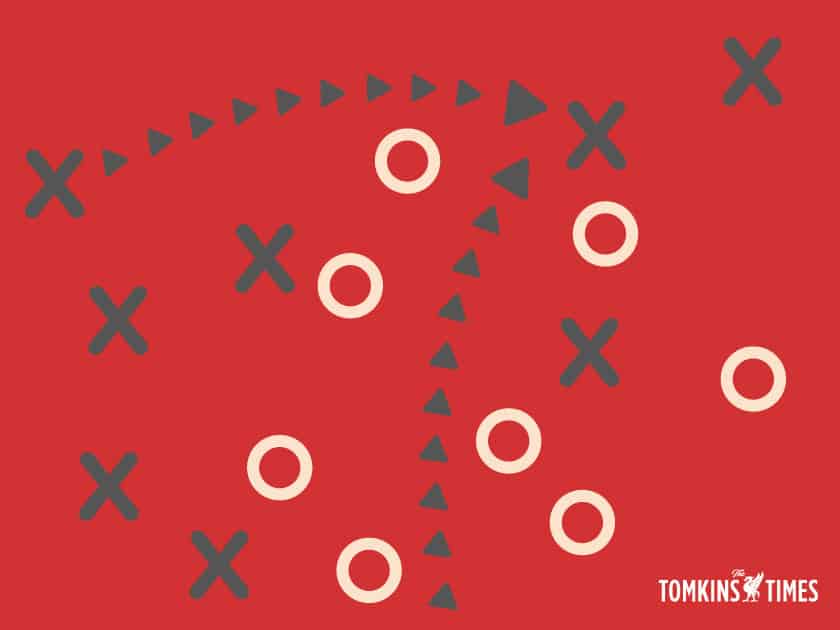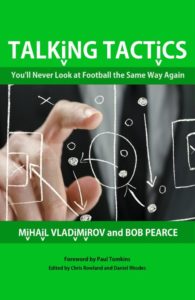
By TTT Subscriber Bob Pearce.
With each passing season we have seen the Premier League battlefield steadily evolve in its tactical sophistication. With the additional arrivals of Conte and Guardiola into the arena of combat, the 2016-17 season will take the tactical expertise to its highest level. How can the average football fans even begin to keep up with the complexities of the contests between these modern-day football masterminds?
Between 2012 and 2015 the ‘Tactics for Beginners’ series by Mihail Vladimirov and Bob Pearce on The Tomkins Times was intended exactly for the fan who wanted to get a grasp of basics of modern footbal tactics.
As part of that series of 18 articles Mihail shared his observations and insights on some of the tactical wizards we will see working their magic in the Premier League this season.

Extract from the chapter ‘A 1-2 and a 2-1’
Can a 1-2 ever have a two that are both attack-focused?
The only way for a 1-2 triangle to safely support two attacking midfielders is the 3-1-4-2 shape. Having the security of a back three unit which is further anchored by the presence of the ‘1’, means the midfield duo could be freed even more in attack. This is the model Juventus play under Conte.

Extract from the chapter ‘The main conductor’
Which coaches or managers do you get most excited by today and what is it about their work that you find so exciting?
I’m a huge Rafa Benitez fan. He ‘fired me up’ to delve deeper and deeper into tactics and seek to understand everything that is related to them. For me his best trait is his obsessive nature when it comes to the word ‘balance’. Everything from fitness regimes, training, tactics, travelling, transfers, etc. is down to balance.
The next is Pep Guardiola. Not because he managed arguably the best team in football history and ended up with a massive trophy haul at the end of his four years at the Nou Camp. What caught my eye with him was his way of mixing his tactics and always presenting different solutions to different problems. He is the one who I can say is the most fluid manager tactically speaking. Of course, the fact he had all those world-class players was surely a great help to him. But it was his decision to be fluid and try to evolve by adding new ideas every season. It would probably have been easier to just stick with the same plan and ride out his time at the helm of one of the best teams that football has ever seen and just enjoy winning plenty of matches. But instead he opted to try and evolve, to be creative tactically, and demand the same from his players all the time.

Extract from the chapter ‘Tick, tock, tick, tock, tick, tock, Bang!’
Could a team accommodate both types of playmaker?
If we are to speak about a ‘proper’ playmaker in the traditional sense of the word, the answer would have been ‘no’, as you wouldn’t have designated more than one player to be the team’s main playmaker. You can’t have two ‘Registas’ or two ‘Trequartistas’, they would get in each other’s way. But, as the game has evolved, you could now have a ‘Regista’ and a ‘Trequartista’, with both of them designated certain zones to play within and specific roles to execute as part of the bigger tactical plan.
It would give the team an increased ability to fashion goal-scoring chances from different zones and in different ways, hence making it almost impossible for the opposition to properly nullify both of them. Real Madrid under Mourinho (with Alonso and Ozil) or Dortmund under Klopp (with Sahin and Gotze/Kagawa) were good examples. You may try to focus on shutting either of them down but the other would still be in a position to hurt you. It is almost impossible to shut them both down simultaneously. So it is not a surprise that these teams were playing 4-2-3-1 and were capable of hitting opponents hard on the break with just a few passes, while also out-passing and over-running teams with tons of possession and plenty of attacking directions.

Extract from the chapter ‘Inherent spells of vulnerability’
Is Mourinho’s ‘team of least mistakes’ philosophy the logical conclusion of the increased importance associated with transitions?
In a way, yes. Mourinho is famed for being mainly concerned and deeply interested in what happens in those transition moments, and from a purely theoretical point of view he is right. It’s really hard to break down a team that’s well-drilled and already well set in their defensive shell. But every team, regardless of their individual quality, formation, tactics, etc., will be vulnerable in those moments when everything is up for grabs (in those transitions when ‘the coin is still spinning in the air’).
If you can master these moments you’ll always have a huge advantage, and a major part of that is to make as few mistakes as possible when your team transitions. Each mistake will gift the opposition a valuable opportunity to hurt you during the next wave of transitions. And given how big an impact such moments can have, it’s really important that you aren’t making cheap errors during either transition. The team that can avoid making mistakes while also being well equipped and drilled to pounce on each mistake the opposition makes will increase their chances to inflict greater damage more often. This is precisely why Mourinho’s teams are so hard to play against. They are superbly well-drilled defensively, rarely make mistakes and are coached on precisely how to maximise the transition moments.

Extract from the chapter ‘Enforcing behaviour’
Would you say that who is dictating the tempo of the game is more important than who has greater possession?
In a way, yes. Possession alone doesn’t lead to control of the game, or the ability to create chances or deny the opposition chances.
Picture Red team having possession deep in their own half. By having the ball, Red team will deny Blue team the opportunity to create many chances or raise the tempo of the game. But by having possession in such unthreatening zones, the Red team will equally be unable to hurt the Blue team.
However, the Blue team’s behaviour should be taken into account here too. If they are on the back foot, sitting deep and standing off, the Red team with possession deep in their half would be dictating both the tempo and how the game would be played. But if the Blue team is focused on fierce pressing from higher up (where the majority of the possession is), it might lead to the Red team becoming uncomfortable in possession.
Rodgers’ Liverpool vs. Pochettino’s Southampton at Anfield was a great example of this. The Saints appeared to deliberately cede possession to Liverpool in order to press them and force the game to be played in Liverpool’s half. While the Reds may have controlled the possession, the visitors dictated the tempo. It proved an excellent example of how controlling the tempo is much more useful than simply having the majority of the ball.

Extract from the chapter ‘Let the shape do the work’
Last time you spoke about which coaches you respected most. Which coaches do you think are over-rated?
You may expect me to name some manager that fans and the media regard as a genius and then explain why I think he is ‘rubbish’, but I don’t think there are managers who are ‘useless’.
However, one manager I don’t value so much as many others do is Wenger. As I said I don’t think he is a ‘rubbish’ manager, but to be more specific I would say he is not a very capable manager, or head coach (in the true sense of the role). Tactically he has always been very hands-off and with no clear tactical sense. He is a strategist, who is able to pinpoint a certain style and demand his players play it no matter what. His success came in an era when the Premier League wasn’t overly tactical, and certainly didn’t pose as many tactical puzzles as it has done in recent years.
I think his success in his first five or six years was based on the ‘wow effect’. What he preached back then was totally different to what the Premier League was used to dealing with. He succeeded in securing some really talented players who, playing within his template, were able to dominate.
But once Benitez and Mourinho came to the Premier League, within a year or two the landscape changed totally. The Premier League started to become far more tactical as these two managers quickly showed the true value and power of tactics and detailed tactical management on a game by game basis.
It should not be a surprise that since their first season the Premier League changed from using 4-4-2 to 4-5-1/4-2-3-1 as a template. Wenger’s ‘wow factor’ was soon surpassed, and the fact that he was never a tactical manager made his team less capable.
What is the difference between a strategist and a tactician?
A strategist is someone who is more of a macro-level manager. Someone who sets up his team to play a certain brand of football and is not so interested in delving into the micro tactical details in terms of different patterns of play that take account of the opposition’s strengths and weaknesses. Wenger is the perfect example of a pure strategist. He always plays with the same formation (he changed it three times in ten years) and wants a certain style of play to be carried out on the pitch by his players – i.e. the general strategy. But he wouldn’t create different patterns of play based on the opposition.
On the other side is the tactician who, although having some general idea what type of football he will play (e.g. possession-oriented, more defensive-minded, based on quick transitions, etc.), is more interested in the micro tactical details. How will his team defend to deal with the opposition’s strengths? What type of marking patterns will the players apply (zonal closing-down, man-marking pressing, zonal standing-off etc.)? Which are the opposition’s most vulnerable zones and players, and how is it best to exploit them? Based on this, what type of attacking patterns (including passing and movement patterns) should the team use to improve their chances of nullifying and then threatening the opposition? These are all questions which a tactician will ask himself on a match-by-match basis as he is looking to adapt his team by tweaking the tactical details. Benitez is a good example of a manager who is a tactician rather than a strategist. And, as surprising as many may find it, so was Ferguson.

The full ‘Tactics for Beginners’ series, along with many additional tactical articles including a 2016 Tactical Glossary, is now available in ‘Talking Tactics – You’ll Never Look at Football the Same Way Again’ by Mihail Vladimirov and Bob Pearce, available on Kindle for £4.59.
@TheTacticsRoom said Well worth buying it. It’s an eBook on football tactics & analysis, pretty much, & it’s honestly brilliant. Got a great format & goes into so much detail. If you’re following me then I’m sure you’ll love it. It’ll be the best thing you buy tomorrow though, I promise (unless you get like a puppy or something).
LINK: https://www.amazon.co.uk/dp/B01H248TJ0
Podcast:
// <![CDATA[
var audioTag = document.createElement(‘audio’);if (!(!!(audioTag.canPlayType) && (“no” != audioTag.canPlayType(“audio/mpeg”)) && (“” != audioTag.canPlayType(“audio/mpeg”)))){document.getElementById(‘auidoplayerhtml5podbeanbe73067b7f3b39cd9a116fa1309baf78’).parentNode.removeChild(document.getElementById(‘auidoplayerhtml5podbeanbe73067b7f3b39cd9a116fa1309baf78’));document.write(”);
}
// ]]>
Feedback for the original series from TTT subscribers
I switch off from the tactical pieces as soon as false nines and inverted double false 10’s etc. are mentioned. Hopefully like most things it just needs someone to explain the basics clearly.
flashman
This series on tactics is brilliant. I’ve never been too bothered with the details of tactics, formations, etc., until TTT came along.
Marcus68
This it really a magnificent series if you want to dig into tactics! Bob and Mihail, Thank you so much. This series, and the development within the series, is outstanding!
toshack
Brilliant! It’s like taking an elective in Football Tactics at TTT University with Professor Vladimirov
flododom
Very informative. It will certainly enrich my watching football experience.
seventy7even
Wow… probably the most interesting tactical insights I have ever read. Well Done Bob and Mihail.
Rafa
You two are doing a fantastic job with this, Mihail with his knowledge and detail in his explainations and Bob you have a good knack of asking good questions that provide Mihail the opportunity to answer at length and really get through some very informative answers.
GeniusChrist
The question and answer aspect of it is great. Books about tactics can be very dry and heavy reading. Often, it´s because they don´t paint a good enough picture for the reader, but the questions and answers are done that well here that the reader can get a very good picture of what´s being talked about throughout the chapter. I really like these series it´s like reading a good book one chapter at a time and then can´t wait for the next one. And it will be interesting to read them again at the end of the season to see how much I have learned.
Arnar Steinsson
As a statto, and self-confessed tactical dunce, I find the concept of ‘movement’ in football fascinating. It’s one of the most important facets of the game, and yet it is completely impossible to measure accurately and produce stats on.
Beez (BassTunedToRed)
I dunno if this just hit the right level of understanding for me but this is easily the best thing I have read on the subject of space and hows it’s manipulated and used.
Abe
I want to thank the writers for producing these pieces and educating me. Now sometimes when I am watching the match I can actually see what is about to happen and have a sense of why what is happening is happening, which has taken my appreciation of the game to a whole new level.
Jeff
I will continue to read and re-read and constantly refer to this whenever I watch a game.
Slick Mud